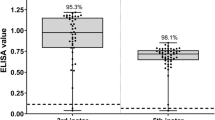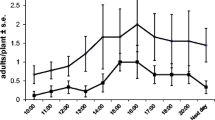Summary
Polyacrylamide gel electrophoresis and subsequent esterase staining provide an alternative to immunological methods for investigating the diet of microarthropods which cannot be observed directly. Attack rates in field populations of Antarctic microarthropods by the predator Gamasellus racovitzai were calculated by proportional and quantitative analyses of electrophoresis results. Results were quantified by transmission densitometry and a digestion curve for ingested prey esterases was defined. An exponential decay model of digestion, incorporating meal size, was used, and a method potentially enabling both the time since feeding and the composite meal size to be estimated for individual predators is described. These methods are applied to samples of predatory mites collected from the Antarctic Peninsula. Although estimated attack rates were low, about 0.1–0.3 prey per predator per day, they may be sufficient to cause severe local reduction in prey density.
Similar content being viewed by others
References
Block W (1984) Terrestrial microbiology, invertebrates and ecosystems. In: Laws RM (ed) Antarctic Ecology I. Academic Press, London New York, pp 163–236
Dempster JP (1960) A quantitative study of the predators on the eggs and larvae of the broom beetle Phytodecta olivacea Foster, using the precipitin test. J Anim. Ecol 29:149–167
Fitcher BL, Stephen WP (1981) Time related decay in prey antigens ingested by the predator Podisus maculiventris (Hemiptera, Pentatomidae) as detected by ELISA. Oecologia (Berlin) 51:404–407
Giller PS (1982) The natural diets of waterbugs (Hemiptera-Heteroptera): electrophoresis as a potential method of analysis. Ecol Entomol 7:233–237
Giller PS (1984) Predator gut state and prey detectability using electrophoretic analysis of gut contents. Ecol Entomol 9:157–162
Holdgate MW (1964) Terrestrial ecology in the maritime Antarctic. In: Carrick R, Holdgate MW, Prevost J (eds), Biologie Antarctique. Herman, Paris, pp 181–194
Lister A (1984a) Predation in an Antarctic micro-arthropod community. In: Griffiths DA, Bowman CE (eds), Acarology 6, II. Ellis Horwood, Chichester, pp 886–892
Lister A (1984b) Studies on the Antarctic predatory mite Gamasellus racovitzai. D Phil Thesis, University of York
Morey F (1978) RFT scanning densitometer model 2955: operating manual. Transidyne General Corporation, Michigan
Murray RA, Solomon MG (1978) A rapid technique for analysing diets of invertebrate predators by electrophoresis. Ann. Appl Biol 90:7–10
Rothschild GHL (1966) A study of the natural population of Conomelus anceps Germar (Homoptera: Delphacidae) including observations on predation using the precipitin test. J Anim Ecol 35:413–434
Usher MB, Booth RG (1984) Arthropod communities in a maritime Antarctic moss-turf habitat: three dimensional distribution of mites and Collembola. J Anim Ecol 53:427–441
Usher MB, Bowring MFB (1984) Laboratory studies of predation by the Antarctic mite Gamasellus racovitzai (Acarina: Mesostigmata). Oecologia (Berlin) 62:245–249
Author information
Authors and Affiliations
Rights and permissions
About this article
Cite this article
Lister, A., Usher, M.B. & Block, W. Description and quantification of field attack rates by predatory mites: An example using an electrophoresis method with a species of Antarctic mite. Oecologia 72, 185–191 (1987). https://doi.org/10.1007/BF00379265
Received:
Issue Date:
DOI: https://doi.org/10.1007/BF00379265




